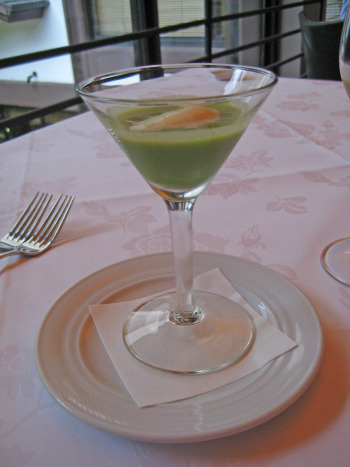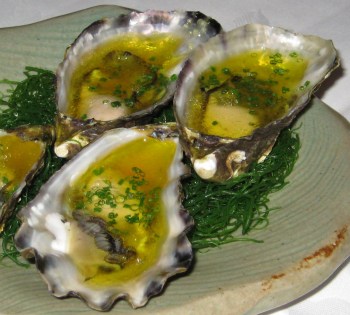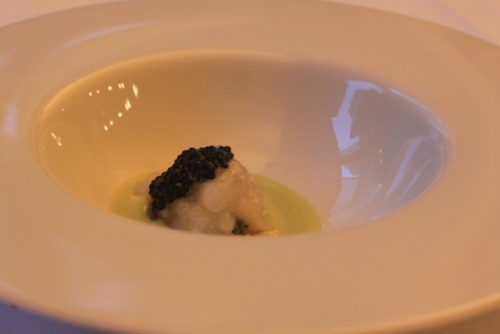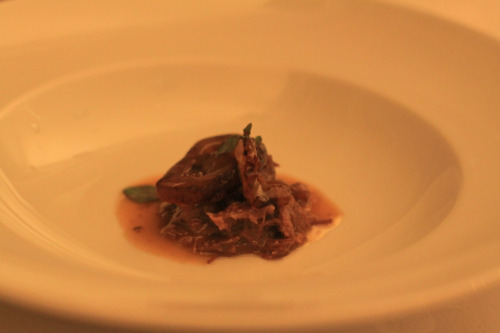On 10th November 2010 one of my favourite people in the whole wide world turned 21. Sadly, as I live on the other side of the world I missed the big day and the big party thrown in her honour a few days later. So I wanted to do something special to make it up. That special something was Tetsuya’s.
“Tetsuya's cuisine is unique, based on the Japanese philosophy of natural seasonal flavours, enhanced by classic French technique and the freshest possible ingredients.” It has long been considered among Australia’s top restaurants. It has won numerous awards, including restaurant of the year almost every year since 1992 from various sources, best Australasian restaurant on six occasions, and a place on the world’s 50 best restaurant list since 2002, coming fourth in 2005 and fifth in 2006 and 2007. Until this year Tetsuya’s had retained three chef’s hats, the highest rating in the Sydney Morning Herald Good Food Guide (akin to three Michelin stars). I was disappointed to learn that it had lost a hat in the year I finally decided to go, but my friend Dash put a positive spin on it: “It will be even better; they’ve given him a kick up the bum."
When we arrived we were greeted at the door by not one or two, but four people. We were taken upstairs into one of the two main dining rooms, where the very (if a little overly) friendly maitre d’ asked us whether we had been to Tetsuya’s before (I think it was obvious we were not their usual clientele), whether it was a special occasion (yes, my sister’s 21st birthday), and whether we had any allergies or dislikes (not that we knew of, although that was soon to change).
 The wine list was a veritable tome, 38 pages it required a contents page to navigate it. Price wise, the wines ranged from $40 to $27,000. I kept my choices within the two (white) to three (red) figure brackets and found that there was plenty to choose from; if anything too much. With a little help from one of our waiters we settled on a gruner veltliner from Austria (crisp and fresh, but not too dry, it was a good match for the seafood dishes) and later a Gigondas (a grenache/shiraz blend from the southern Rhone in France to accompany the meat courses).
The wine list was a veritable tome, 38 pages it required a contents page to navigate it. Price wise, the wines ranged from $40 to $27,000. I kept my choices within the two (white) to three (red) figure brackets and found that there was plenty to choose from; if anything too much. With a little help from one of our waiters we settled on a gruner veltliner from Austria (crisp and fresh, but not too dry, it was a good match for the seafood dishes) and later a Gigondas (a grenache/shiraz blend from the southern Rhone in France to accompany the meat courses).
The meal got off to a perfect start with a chilled cucumber soup with sheep yoghurt ice cream. The soup was light and refreshing lifted by a slight hint of vinegar, similar to gaspacho but more refined. The ice cream alone would have been too sweet for a savoury course, but that was counteracted by the tangy, salty soup.
 The optional course was pacific oysters with rice vinegar and ginger, a title which does the dish no justice at all. The dressing was sublime, and contained a number of other significant ingredients that went unmentioned. The most notable was the caviar-like pulp of native finger lime, bringing both a burst of citrus and a wonderful textural contrast in what would otherwise have been an entirely slippery affair. Despite the complexity of the dressing, it still managed not to overpower the oysters, which provided a creamy, slightly bitter finish.
The optional course was pacific oysters with rice vinegar and ginger, a title which does the dish no justice at all. The dressing was sublime, and contained a number of other significant ingredients that went unmentioned. The most notable was the caviar-like pulp of native finger lime, bringing both a burst of citrus and a wonderful textural contrast in what would otherwise have been an entirely slippery affair. Despite the complexity of the dressing, it still managed not to overpower the oysters, which provided a creamy, slightly bitter finish.
It is, of course, obligatory to discuss Tetsuya’s signature dish, the confit of Petuna ocean trout. Obligatory but not onerous. Anyone who has dined at Tetsuya’s since 1992 has had this dish in some form or another. In his book, Tetsuya writes:
Over the years, the ocean trout has undergone every cooking technique you can imagine... today, it is gently cooked in Spanish or Italian olive oil.
Gently is an understatement. The meat is so delicately cooked that I wasn’t convinced it had been cooked at all and I certainly couldn’t work out how. I know confit to mean cooked in fat, and usually a lot of it. These days the term is used more liberally and might refer to poaching or the sous-vide method, but even this seemed unlikely.
As it turns out, the fish is marinated in olive oil with various seasonings, then removed from the oil and cooked for 7-8 minutes in an oven set to the “absolutely lowest setting possible” with the door open. “The flesh should not have changed colour at all, but remain brilliant orangey-red”. No wonder I was confused.
The reason this dish is so successful is that it has all bases covered: the smooth and silky flesh of the trout is contrasted with the crisp salad of celery and apple. The apple, in particular, is a clever choice bringing an element of sweetness to the dish. The salad is dressed in a tangy, slightly tart lemon dressing, which is well balanced with the rich trout flesh. The salty konbu, in which the trout is encrusted, provides a unique and attractive seasoning.
There were only two dishes that didn’t wow us, and we didn’t dislike either of them. The marinated NZ scampi with avocado soup and avruga was a lovely combination of flavours, but I am not a big fan of raw crustaceans; it just doesn’t do it for me texturally. My sis thought she probably felt the same, but wasn’t sure as she had never tried it. As it turns out she does have an allergy, nothing serious, but it gave her an unpleasantly itchy mouth.

The other dish that didn’t quite hit the mark was the braised oxtail with sea cucumber and yuzu. Again it was a problem with the texture, which was altogether too slimy. This was not helped by the sea cucumber which, in my opinion, should have stayed where it belonged; at the bottom of the sea. Still, the oxtail was meltingly tender and the flavour, rich and gamey as it should be.

This disappointment was soon remedied by the arrival of the pancetta wrapped quail breast with fresh sprouts and onion, the highlight of the meat dishes. Cooked medium rare, the moist, tender flesh contrasted beautifully with the crunchy sprouts and onion. The freshness of the salad was well balanced with the salty pancetta wrapped meat and the sprouts added a delightful nutty flavour.
Now I am not usually one for desserts, but these were exceptional. I could easily write something about all of them, but there were five and this is already turning into a rather lengthy post. The highlight then, although it is hard to choose, was the orange sorbet. Some might think this sounds simple, and therefore dull, but there was a twist – pepper! The initial taste was everything a good sorbet should be – sweet, but slightly tart, fruity and refreshing; the perfect palate cleanser. Then, wow, what a pleasant surprise – a spicy finish. I liked it so much I ate it all before Charlie reminded me to take a photo.
I can’t tell you exactly how much it cost, because my sister is one of my most avid readers, but let’s put it this way, it was the first time I have been and probably the last, and that is not because it was not fantastic, but because it truly requires a special occasion to justify it. And my sister is very special, birthday or not.
Perhaps surprisingly, Tetsuya’s is not pretentious food; there are no fancy foams, essence of this or that, no ‘deconstructions’. When my sister and I recounted the meal to her boyfriend, a chef, he was surprised at the simplicity of the dishes. Sure, a huge amount of thought and preparation goes into each one, but the essential flavours are not overly complex. The review in this year’s Good Food Guide calls this ‘understated’, I would call it delicate and well balanced. In Tetsuya’s words,
I hope that diners will think that the food they eat in my restaurant is an honest use of prime produce, and appreciate the subtleties that I try to preserve. For me, a successful dish is when no one flavour overwhelms the other, but all coexist harmoniously.
In seeking to justify the loss of a hat in this year’s Good Food Guide, the reviewer asks “put aside the hype and what do you have?” Their answer:
A destination restaurant of great, if subdued, elegance, in which hushed diners and a battalion of staff move on a reverent journey through a 12 – 14-course parade of small dishes that unfolds with meticulous precision.
And? What exactly is the problem with that?
Tetsuya’s restaurant, 529 Kent St, Sydney, NSW, 2000; +61 2 9267 2900. Bookings are essential and should be made well in advance.
Tues-Fri: Dinner from 6pm; Sat: Lunch from 12pm, Dinner from 6.30pm.
11 course degustation $210; with matching wines $305; Wines start at $13 by the glass and $40 by the bottle. Four sparking, eight whites and seven reds by the glass.